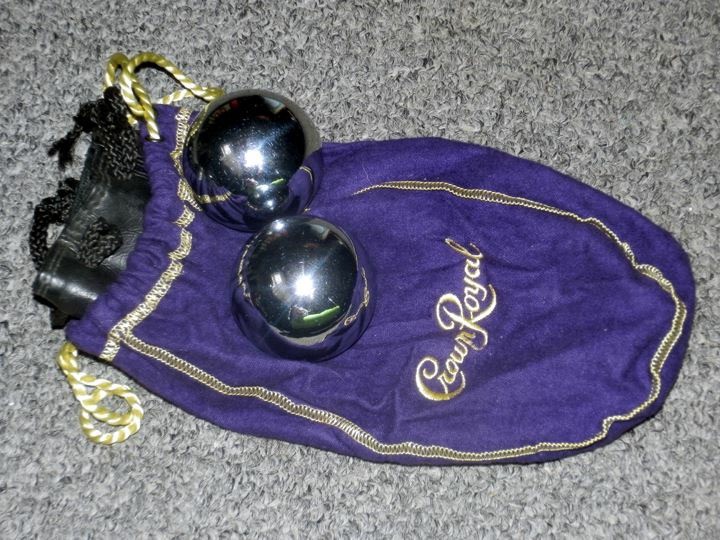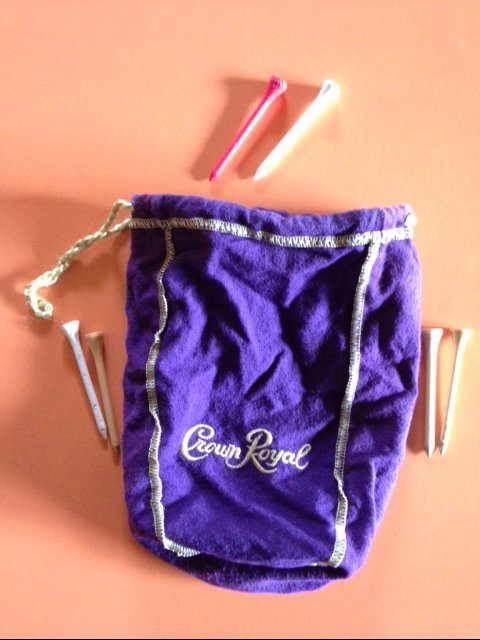For Keeps

If you’ve ever bought a bottle of Crown Royal Canadian whisky, you know the iconic bag, that ubiquitous purple “velvet” satchel with gold stitching and tasseled drawstring. Nearly everyone has one, even if they’re unsure where it is, or even how they got it. They’re impossible to throw away, and are just the right size, perfect for, say, a camera lens, weed stash, or as a relative used it for, an old set of dentures. Heck, I had one moons before I even knew about the whisky, and was probably using it to store Tiddlywinks, or my Indian Head pennies.
The bag does go back generations. In fact, the Canadian distillery’s first batch of hooch was blended in 1939 for the premier visit to the Americas by none other than England’s King George VI and his wife, Queen Elizabeth. No reigning British monarch had ever set foot on the continent. Upon hearing of the impending visit, Seagrams Chairman Samuel Bronfman sought to create a whisky, well, suitable for a king. He was said to have sampled six hundred blends before approving the recipe, the etched-glass crown-shape bottle and cap and now-venerable purple bag, the color chosen to imbue royalty.
For many subsequent years, the purple bag and its contents remained under wraps in Canada. That ended in the 1960s, when some enterprising Canadians, having packed some purple pouches, headed for oil-rich Texas. After that the blended whisky and their bags were also sold in the United States.
It’s Crown Royal’s aim that that whole “royal” vibe endures. “You get a box, you pull out the bag, and you get a bottle topped with a crown. It’s an absolute ritual that we know consumers love,” said Yvonne Briese, Crown Royal’s vice president.
These days, about fifty million bags are stitched for Crown Royal annually, up fifteen percent from last May. Although there are now nine bag colors, representative of variants in the Crown Royal series, the most popular by far is that purple bag, which houses Crown Royal Deluxe, the producer’s original whisky. “The bags are extremely important to the overall brand,” Briese said.
For competitive reasons, Briese can’t disclose where the bags are produced, except that it’s somewhere in Canada, where Crown Royal’s most notable plant is in Amherstburg, Ontario (the whiskies are made in the rural town of Gimli in Manitoba). “We have a bagging machine,” she explained. “If you see it in action, everything is calibrated down to the smallest percentage possible so that bottles fly off and into the bags. It’s a highly efficient machine. The machine is very sensitive, so vendors are carefully chosen.”
The bag has basically remained the same, although it once bore the Seagrams name (Crown Royal, which produces the United States’ top-selling Canadian whisky, is now owned by Diageo). The bag itself — probably made of felt, although Crown Royal couldn’t say — was trademarked in the mid-1960s.
Aware of the bag’s immense popularity, Crown Royal uses it to benefit others. For example, the manufacturer has hosted hundreds of bag-stuffing events throughout the country, creating over 100,000 care packages for active-duty military members overseas. In turn, some of the bags have been used to protect equipment like night goggles, Briese said.
In some markets consumers can donate Crown Royal bags to stores, and, for every bag donated the distillery gives $1 to a charity partner.
Crown Royal is making some money from the bags themselves, although it won’t disclose how much, and says it’s nominal. Since about the last decade, consumers have been able to order custom sacks sans the bottle, with their own message stitched on it.
Crown Royal has also been known to accommodate special requests for, say, bags for a bedspread for a spouse. “We work it out,” Briese said. “We know the bags are a source of pride.”
Indeed, homemade creations run the gamut, many of them available through sites such as eBay. Also online are instructions for how to make elaborate Crown Royal quilts.
Some works find their way to Crown Royal, which displays them in its New York office. And in 2010, to commemorate Crown Royal’s history while celebrating its present, Crown Royal asked fans through an open call on Facebook to submit their creations. The manufacturer subsequently created a book for loyal customers of some of the most imaginative submissions and their stories. Those entries include a blazer, bra, hoodie, smoking jacket, onesie, Halloween costume, Russian winter hat, dog scarf, Christmas stocking, cape, “do-rag,” evening slippers, travel bag, makeup case, stuffed animal, steering wheel cover, pool table cover, Christmas tree skirt and poker table cover.
One woman in the book had crafted a kilt for her husband’s fiftieth birthday. The outfit includes a vest, crown and pint-ready flask bag. In one of the more poignant entries, Bobby Henline, of San Antonio, Texas, used a bag for his prosthetic arm. His post read: “I lost my left hand due to burn injuries sustained by a roadside bomb in Iraq during my fourth tour. My prosthetist told me to bring in any material that I want for my prosthetic arm, so I brought in my favorite purple bag that I picked up in Fort Bragg, N.C.”
Rather than being used to construct something, most of the bags are simply used as … bags. For example, Crista Huff of Highlands Ranch, Colorado, used one for years for pocket change. Her husband had bought a bottle of Crown Royal, and she took the bag. Somewhere, Barbara Jo Bagby Enterline, of Alice, Texas, has a pair of saltwater pearls in a bag. “A few years ago my husband told me to order them for an anniversary present before he died,” she said. “Somebody gave me a bottle of Crown Royal. I don’t drink, but I eventually put ivy in the bottle and put it in the window. I put my pearls in the bag. It’s soft and I don’t have to worry about scratches. Plus, purple’s my favorite color.”

John Martin’s golf tees.
John Martin of Riverview, Michigan, uses a bag for his golf tees. Detroiter James Feagin keeps business cards he collects in one; another holds rare currency and baseball cards. And yes, he does drink the whisky. Ken Amey of Saginaw, Michigan, re-gifted the booze but kept the bag. He uses it for vintage watches. Lawrence Dilworth of Detroit uses his sack for ancient Chinese baoding balls.
“I’ve got one covered in lint that I’ve had for quite so me time,” said April Mowler of Chicago. “Over the years I’ve kept everything in it. You know,” she chuckled, “I bet these bags are like what they say about fruit cake: There’s only one, and it gets passed around eventually to everyone else.”
Photo: Lawrence Dilworth
